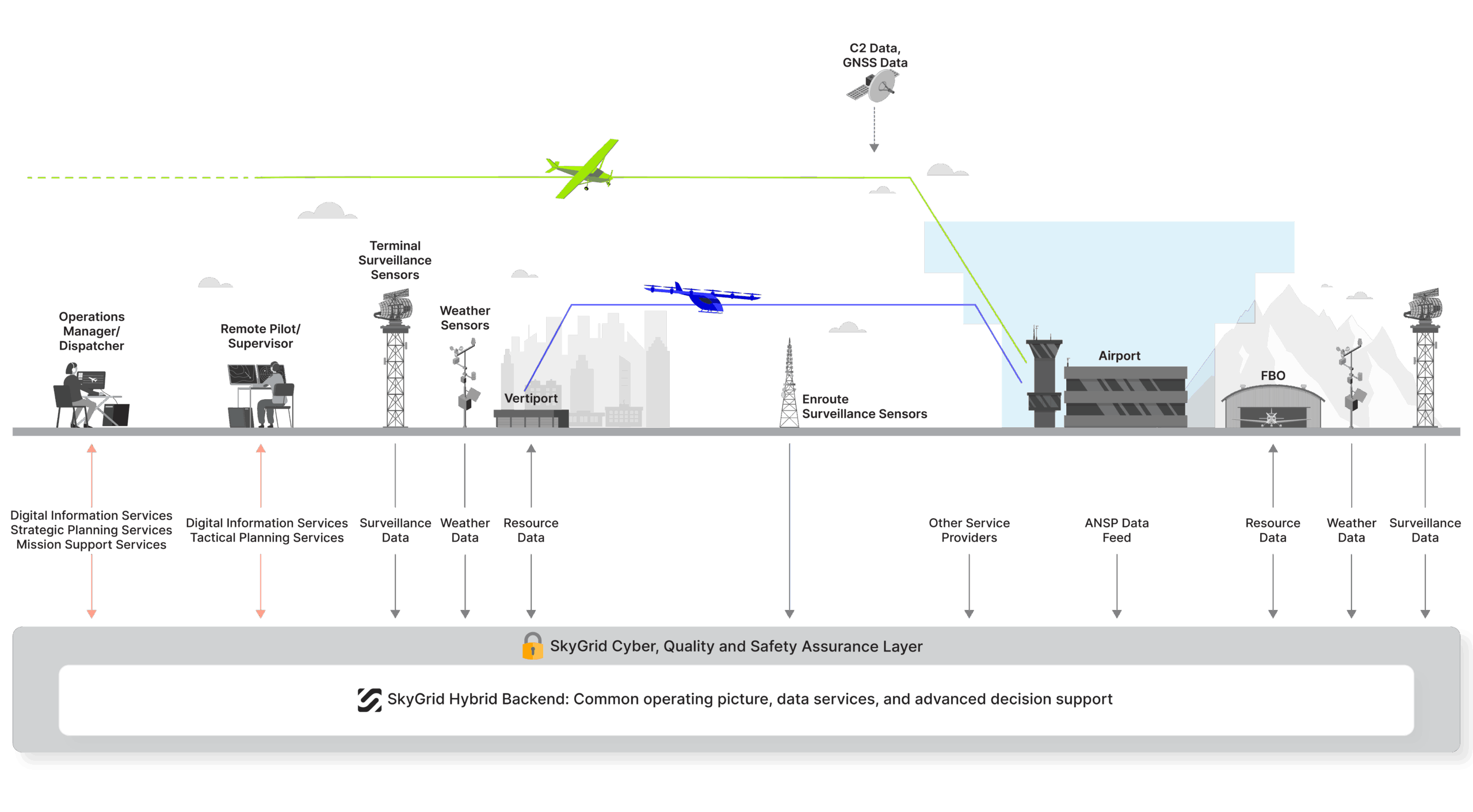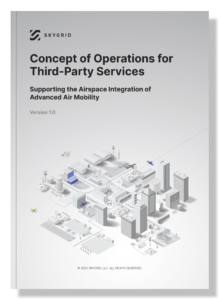Advanced Air Mobility (AAM) operations are expected to enter service in the coming years, operating under both Visual Flight Rules (VFR) and Instrument Flight Rules (IFR). Crewed operations will take place under both VFR and IFR, while uncrewed operations are expected to occur under IFR only.
The first AAM flights taking place in complex low-altitude environments will require a detailed understanding of their operating environment to avoid hazards and safely navigate airspace constraints. With the introduction of uncrewed vehicles, these operations will also require new data services to maintain their situational awareness on the state of the environment and aircraft without a pilot onboard.
New solutions are needed to integrate and scale these advanced operations, while also ensuring that they behave predictably, don’t disrupt existing operations, or increase the workload of air traffic controllers. As a Third-Party Service Provider (TSP), SkyGrid is developing ground-based capabilities to support the airspace integration of these emerging operations.

SkyGrid’s Solution: Ground-Based High-Assurance Services
SkyGrid’s system offers users Digital Information Services, Strategic Planning Services, Tactical Planning Services, and Mission Support Services. Through these services, we aim to:
- Provide a high-fidelity digital representation of the operating environment to aid situational awareness and decision making.
- Enable uncrewed AAM operations by providing low-latency traffic surveillance data needed to satisfy collision avoidance requirements.
- Increase efficiency and predictability of operations by providing flight planning solutions based on airspace knowledge and resource availability.
- Streamline airspace access and help scale AAM operations in ways that minimize the need for ATC intervention.
Digital Information Services provide operators with information about their operating environment to support situational awareness. As an example of a service in this category, Ground-Based Traffic Surveillance (GBTS) integrates traffic information from several surveillance sources to create a complete traffic picture of the operating environment. Data received will include tracks for cooperative and non-cooperative aircraft, and the SkyGrid system will provide real-time data on the performance of surveillance systems and expected coverage volumes. Another service, Resource Status and Capacity Data, provides information on capacity-constrained resources, including vertiports, airport runways, FBO parking stands, and AAM routes. This service will receive and integrate data from vertiport, FBO, air navigation service provider (ANSP), and Air Traffic Management (ATM) systems.
Strategic Planning Services help users plan safe, efficient, and predictable flights that satisfy airspace constraints. A Flight Plan Validation service will ensure flight plan feasibility up until the scheduled departure time. This service will monitor dynamic hazards and constraints such as airspace closures, availability of surveillance services, hazardous weather, resource capacity, and changes in airspace configuration. Simultaneously, SkyGrid’s Traffic Synchronization service will monitor real-time traffic conditions and the near-term availability of capacity-constrained resources along the flight route. To ensure correct aircraft separation, this service may suggest slight adjustments to the scheduled time of departure.
Tactical Planning Services support operators in managing in-flight hazards and constraints affecting air traffic. A Flow Management service monitors traffic flow and issues advisories to assist in maintaining an orderly flow of traffic on AAM routes and at vertiports and airports. SkyGrid’s system will monitor in-trail spacing between aircraft, as well as expected arrival times at waypoints, vertiports, and airports. A Ground-Based Detect-and-Avoid (GBDAA) service will provide alerts and advisory guidance to operators to remain well clear of traffic in both visual and instrument meteorological conditions. If well-clear separation is lost, this service will also advise collision avoidance.
The Future Airspace
To support near-term and mid-term AAM operations, SkyGrid will provide services in an advisory capacity, assisting operators with current tasks and enhancing their situational awareness. In the longer term, our system will provide the airspace with traffic management capabilities that will allow for routine AAM operations to be managed with less direct involvement from ATC.
To learn more and for a full list of SkyGrid’s services, read our Concept of Operations for Third-Party Services Supporting the Airspace Integration of AAM.

